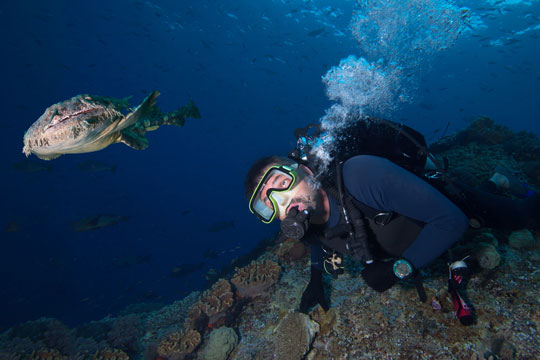To a novice scuba diver, diving with a wobbegong shark may seem like a dangerous activity. But this fear would come from the word “shark” not from the risk of diving with this unique fish.
Features of the Wobbegong Shark
The wobbegong shark is a slow-moving shark that spends most of its time lying flat on the seafloor; commonly under ledges or in caves. It is found in the shallow waters of the western Pacific Ocean, and is common on Australia’s Great Barrier Reef.
A mature shark will generally grow to a bit over two metres, though they can grow to three metres.
One of the wobbegong’s favourite food is crayfish. Most scuba divers who dive on coral reefs know the scuba diving principle that if there are wobbegongs lying in the bottom of a cave, there will also be crayfish about.
Appearance of the Wobbegong Shark
This shark is commonly referred to as a “carpet shark”. This is mainly due to the mottled appearance that looks like an old carpet; and also because they lie around on the sea floor or the bottom of caves like a carpet.
The wobbegong’s skin, though looking soft, is very tough.
It has small teeth that curve inwards and are mainly around the centre of the jaw. A small beard of weed-like fronds hang around the mouth which attracts small fish that probably think the wobbegong’s beard is plant growth, especially if the wobbegong is camouflaged and lying quietly on the seafloor.
It is believed the name wobbegong is of Aboriginal origin, coming from the description of this beard, with the Aboriginal word meaning “shaggy beard”.
Threats to a Scuba Diver From a Wobbegong Shark
Even though the wobbegong is a peaceful shark, it does present some risks for scuba divers.
As above, the wobbegong’s mottled skin gives it an excellent camouflage making it sometimes difficult to see. This can lead to a scuba diver accidentally kneeling on the shark while exploring a cave.
The wobbegong is so flexible it can swing around and bite its own tail. This can result in the shark biting a scuba diver and once it has latched on, it can be difficult to make it let go.
A wobbegong shark firmly latched onto a diver can lead to a dangerous situation. It won’t bite off a diver’s hand or a limb, but it is potentially dangerous situation because it is happening underwater. Even worse if it happens on a decompression dive and there exists the possibility of needing a decompression stop during the ascent. The scuba diver may be stressed, bleeding, or both.
The most common situation where scuba divers strike trouble with a wobbegong shark is if the diver pokes, prods or tries to grab hold of the shark. Another common problem is if the scuba diver accidentally traps the shark in a cave. The shark can panic as if doesn’t have a clear way out of the cave.
The wobbegong shark, if a scuba diver treats it with the respect due to any marine creature, should not present a risk.









